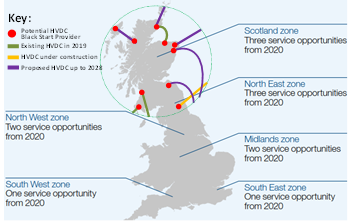The HVDC Centre leads the improvement of Great Britain’s Black Start capabilities using HVDC.
Click here to read the full report published on 4 December 2019.
The evolution of a low carbon economy is driving changes in the electricity system. The changing profile of electricity generation in GB results in a lower system ‘inertia’ making the network more vulnerable to outages in the future. ‘Black-Start’ services are required to re-energise the electricity grid following a system shut down.
GB’s current Black Start strategy is based on 6 zones (see Figure below) with Scotland and the North of England being most vulnerable in terms of low system strength due to the high concentration of renewables.

HVDC has the potential to provide excellent black start capabilities (as well as fast frequency support and synthetic inertia services), and there are a significant number of HVDC schemes planning to connect to the GB network.
With costs rising of providing Black-Start services over the last 10 years, the Scottish Government wanted to investigate how to maximise the use of HVDC schemes to support Black-Start energisation, from a technical perspective and commissioned the HVDC Centre to lead this review..
The HVDC Centre methodically reviewed how HVDC schemes can be utilised to support Black Start energisation
The HVDC Centre technical experts, in collaboration with specialists from SHE Transmission, Scottish Power, National Grid and the Scottish Government, carried out an in-depth study which included:
- Review of existing Black Start arrangements in GB alongside analysis of how HVDC schemes perform against Black Start technical requirements;
- Evaluation of global HVDC Black Start experience and examination of global black-out events;
- Mapping these findings against GB’s current and future HVDC schemes (with a focus on Scotland and the North of England) to identify practical opportunities; and
- Developing specific recommendations, in consultation with Stakeholders, to maximise the use of HVDC schemes for improving GB’s Black Start arrangements
Outcomes
Out of this technical analysis, seven key recommendations are being progressed with relevant stakeholders.

Impact
These recommendations will help improve GB’s Black Start capability by maximising the use of HVDC schemes.
Leading to the following benefits:
- Improving the stability of the Network (reducing the likelihood of outages);
- Facilitating quicker restoration times;
- Reducing the cost (to consumers) of Black Start services; and
- Providing assurance that restoration services will operate as expected when required.
Key Outputs
The key finding of the project were presented in technical reports, networks magazine article, industry conference and summarised on the HVDC Centre webpage:
- The full report published on 4th December 2019 is now available online at: https://www.hvdccentre.com/wp-content/uploads/2019/12/HVDC-BS-001-041219-v2.0.pdf;
- A summary article published in Networks Magazine on 6th November 2019 is available at: https://networks.online/gphsn/analysis/1001865/alternative-route-black-start; and
- Slides presented at the Low Carbon Innovation Conference in Glasgow on 30th October 2019 is available at: https://www.hvdccentre.com/wp-content/uploads/2019/10/LCNI_BlackStart_Day-1-15.30.pdf.
Also, recommendations on investigation of AC protection performance and role of synchronous compensation across HVDC black start and restoration have now been included in the themes for the 2020 HVDC Call for Research Proposals, which aims to undertake further analysis in consultation with research institutions and universities.

